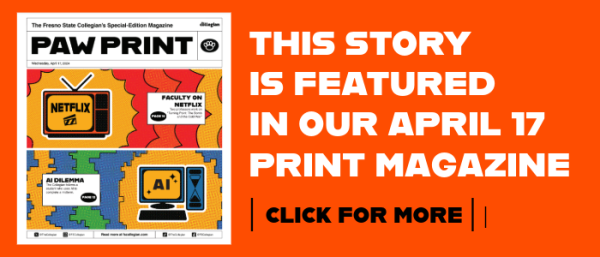Disclaimer: Neither The Collegian nor the author of this article are promoting or encouraging the use of AI to complete assignments in class.
It’s 8 p.m. on an October night and the heart of midterms for Fresno State students. A student majoring in engineering is diligently working with classmates on the first of three engineering-course projects due by midnight.
The student begins scrolling through their upcoming Canvas assignments. Searching for the link to turn in the first project, the student is surprised to find listed an essay due at midnight for Chicano studies, a general education class.
A wave of anxiety flows over the student. They hastily scan the prompt realizing they need to turn in a 1,500-word midterm essay with the possible topics ranging from Cesar Chavez to lowrider culture.
The student stares at the prompt, questions the logic of having to take the class in the first place and ponders the feasibility of writing a 1,500-word paper and completing two projects in less than four hours.
The student decides that they won’t be writing this paper under their own accord, but instead will use artificial intelligence to help complete the assignment.
“You have to understand, I’m not a writer in any sense,” said the student, who agreed to share this real-world, unvarnished account of how easy it is to use AI to cheat on the condition of anonymity and the use of non-gender-specific pronouns.
The Collegian is opting to tell the story this way to illustrate the magnitude of the impact AI is already having at Fresno State, along with the steps that many professors are using to combat it. Universities across the country are struggling to keep up with the evolving technology. Fresno State recently formed a task force to confront the issue.
For the engineering student, using AI is a calculated risk.
“I’ve always been a numbers kind of [person],” the student said. “That’s just what I’m comfortable with. That’s the main reason I got into using AI in the first place. I never wanted to take any of these [general education] classes. But if I do, I’m going to figure out how to use as little writing as possible.”
Time continues counting down to midnight. Now, down to the details. How will the student use AI to write the essay? Is the time and effort used to generate the essay better than not writing it? And most importantly, will they get away with it?
How is AI transforming higher education classrooms?
With the recent explosion in AI’s popularity and its growing use by everyday internet users, the subject has gained considerable notoriety following the COVID-19 pandemic.
AI isn’t strictly favorable or harmful to universities, but there are methods in which the technology can be, and is already, used to substitute class work.
This comes from the use of AI chatbots and generators, such as the infamous ChatGPT engine developed by OpenAI.
These programs specialize in having “human-like” responses when prompted and generating long, information-filled responses that can be put into essay format.
A 2023 study by the BestColleges website found that 56% of college students have used an AI writing tool in some capacity. The study found that “some student groups are more likely to report using AI tools to complete college coursework than others. Business and STEM majors, men, and millennials are more likely than humanities majors, women, and Gen Z to report using the tools”.
University faculty members have been forced to adapt to newly employed student tactics.
Various institutions have chosen to combat this with preventative measures such as Lockdown Browser, an internet browser that monitors students’ devices for signs of cheating while also recording students through their webcams.
Some professors ratchet back digital technology altogether by requiring students to use blue books or other handwritten methods during in-class exams.
This, along with AI “checker” apps that purport to be able to detect the use of AI — and, which have had their reliability questioned — has produced mixed results at best. Due to this, some university faculty have turned to embracing the advancing technology.
“It’s definitely a topic of interest,” said Danny Kim, Fresno State assistant history professor. “On the one hand, it poses new challenges for college education. On the other hand, it does present a lot of opportunities for us to rethink assignments.”
Method to the AI madness
For the student in this story, time is limited. They know each of their engineering projects will take more than an hour to complete. There is less than half an hour to generate and turn in this essay.
Despite the time crunch, the student is careful in using AI to complete their work.
“If you just put a prompt into ChatGPT and turn that in, you’re going to get caught,” the student said. ”Professors aren’t dumb. In fact, I think a normal person can tell if something is AI-generated if you’re not careful.”
For those who frequently use AI, it is much more akin to a process rather than one-time use.
While an average student may use AI or search engines to look up answers to an online quiz, writing full-length papers is an art form within itself.
“If you’re going to use AI, you have to start planting seeds early on,” the student said. “I wrote the first essay in this class myself, and judging by my professor’s feedback, I made it clear early on that I was not a good writer.”
The student says writing the first essay in a class sets a precedent for professors. The more the student is able to display how sporadic of a writer they are, the more convincing an AI essay will look once they turn it in.
“I’ve had my friends that are English and history majors read ChatGPT essays and say they weren’t that good,” the student said. “But the thing is, I don’t write much better myself. So I’m sure for a professor in an online class that has to read hundreds of these essays, mine in particular won’t stand out.”
The student emphasizes that using AI is situationally specific, including factors such as a professor’s workload, the perceived importance of the class and the professor’s perception of them as a student.. They say the Chicano studies course just happens to be “perfect” for AI-generated content.
Which is why some professors are figuring out ways to adapt to the technology.
Working with AI
An example of this is prevalent in Kim’s pre-modern East Asian history course. His newly implemented writing exercises move away from conventional essays on a topic, replacing them with ones that aim to blend creativity and historical analysis.
“In this course, students write a paper from the first-person perspective of an object. It could be the perspective of a Ming Dynasty vase or a Joseon period moon jar,” Kim said. “They are writing the life story of this object itself, imagining what life would be like as this object while also providing material they learn from the class itself.”
Kim’s innovative assignments aim to provide students an opportunity to rethink the standard history paper, allowing them to bring originality to their writing in the context of information learned in class. The exercises also allow for an option to work around the use of AI.
“I think this is one way of dealing with this challenge of ChatGPT,” he said. “ChatGPT can be creative and regurgitate information that is factual and vaguely accurate, but I try to also pull in the human element.”
“[AI] presents an opportunity to rethink the paper,” Kim said.
Professors across the country are also embracing AI. Marc Watkins, a lecturer at the University of Mississippi, advises his colleagues to promote the use of AI in his classes.
Watkins suggests encouraging students to utilize AI tools in constructive ways, such as brainstorming questions or strengthening their essays with counter arguments.
For Kim, the Fresno State professor, AI presents an opportunity to rethink traditional papers..
“Rather than engage in an assignment meant to regurgitate information that they have learned, I focus [assignments] on empowering students to exercise their creativity,” he said.
The AI “Dance”
With the precedent of AI use being established months prior, the student still has to generate the essay without being detected.
“Generating an essay in a way that won’t get you caught is kind of an art form within itself,” the student said.“There’s a series of programs I use to make sure everything goes down smoothly.”
The first step: inserting a prompt into ChatGPT.
“I’ll usually skim through it just to make sure everything makes sense, and if everything looks cool, then it’s time for step two,” the student said.
After examining the response given to them by the chatbot, the student then copies the entire work and inserts it into a free paraphrasing tool from Grammarly.com.
This tool changes the words from the program while still preserving the essence of what was originally said.
“This part is kind of the trickiest,” the student said. “Paraphrasing is super [essential] to the entire thing.But sometimes the AI gets mixed up, so you have to go fix where it might make the paper sound random.”
At this point, the student puts the text through yet another tool: a QuillBot AI that makes sure a body of writing sounds coherent.
“It doesn’t really change the words that much,” they said. “It really just flags parts of the essay that might not fit the given prompt.”
The final step in the entire process is running what’s left of the essay through GPTZero, an AI detector.
Seemingly the most important step of the process, this program scans the paper for any possible plagiarism that would set off Fresno State’s AI scanning software in Canvas before it is submitted.
“I think what really helped me was understanding what AI is,” they said.“Whenever ChatGPT responds to a prompt I give it, it’s not really writing anything. It’s just like collecting information from the internet. Once I understood that, it made sense why it sets off the scanners.”
Upon passing through the AI scanner, the students skims through the essay. After not picking up any red flags, they submit it through the Canvas portal.
Was it worth it?
With the entire process completed, the question that everyone may be asking themselves upon reading this is: Why?
Why go through all that trouble of using multiple AI programs? Why not just do the essay very quickly? Was doing all that even faster than just writing the essay?
To these questions, the student’s answer is a simple, swift affirmation that it was completely worth it.
“At the end of everything, the process took about 23 minutes,” they said. “I was rushing quite a bit and probably should have read it another time, but my philosophy is to finish it. Out of sight means it’s out of my mind.”
By 8:36 p.m, the student rejoins their study group, the members of which are astonished that the essay was written in such a short amount of time.. The student turns their attention to their engineering projects for the remainder of the night and manages to finish both just before the midnight deadline.
The essay they had just used four programs to complete was completely out of mind, evading their thoughts until the Gmail notification popped up on their phone.
As the student clicks on it, the usual apprehension that follows an AI-generated essay grips their body. They hold their breath, hoping for a passing grade while simultaneously praying that a score of 0/100 didn’t appear, accompanied by a note detailing how they broke university policy.
The student reads the words on the screen and lets out a sigh of relief. They have evaded the scanners again, and all thanks to the help of technology. They can’t help but smile as they see the numbers “85%” written in bold on the center of their phone.





